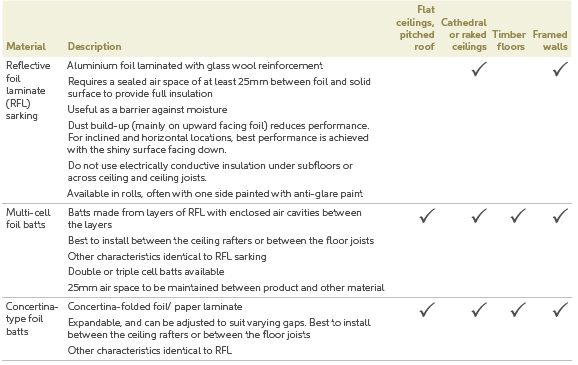Does Using Radiant Barriers Keep Your House Hotter At Night
Properties to look for in a radiant bulwark are high reflectivity and very low emittance (the energy radiated from the cloth's surface), which enable it to reflect the radiant oestrus energy and give off (emit) very petty.
Types of Radiant Barriers
Radiant barriers consist of a highly cogitating fabric, usually aluminum foil, which is applied to one or both sides of a number of substrate materials such every bit kraft paper, plastic films, paper-thin, oriented strand lath, and air infiltration barrier material. Some products are fiber-reinforced to increment durability and ease of treatment. (www.yourhome.gov.au/passive-design/insulation, world wide web.myfloridahomeenergy.com)
Reflective insulation
Radiant barriers can be combined with many types of insulating materials in reflective insulation systems. In these combinations, radiant barriers can act equally the thermal insulation'due south facing material. Reflective insulation is usually shiny aluminum foil laminated onto paper or plastic and is available equally sheets (sarking), concertina-blazon batts and multi-cell batts. Together these products are known equally cogitating foil laminates or RFL.
Reflective insulation mainly resists radiant estrus flow due to its high reflectivity and depression emissivity (ability to re-radiate estrus). It relies on the presence of an air layer of at least 25mm next to the shiny surface. The thermal resistance of reflective insulation varies with the direction of heat menstruation through it. The total R-values for reflective insulation are supplied as 'upwardly' and 'downwards' values. Full values depend on where and how the reflective insulation is installed. (www.yourhome.gov.au/passive-blueprint/insulation)
Common Types of Reflective Insulation

RFL Sarking Installation and Double Side Reflective Aluminium Foil
Multi-cell Foil Batts and Concertina-type Foil Batts
Composite bulk
Composite majority (bulk insulation resists the transfer of conducted and convected heat, relying on pockets of trapped air within its structure) and cogitating materials are bachelor that combine some features of both types. Examples include cogitating foil faced blankets, foil backed batts and foil faced boards. (www.yourhome.gov.au/passive-pattern/insulation)
Foil-faced Fiberglass Roof Blanket and Foil-backed Fiberglass Batt
Movable Radiant Barrier to Forbid Rut-gain of the Roof Slab
From sunrise to sunset, this flexible encompass, with a very shiny lesser, is drawn over the slab. Information technology shades the slab, while its depression emissivity (0.01) due to the shiny surface prevents any radiant heating of the slab. The slab gains some heat from the ambient air yet remains below 30°C. Occupants in spaces under the slab feel cool and a ceiling fan would throw absurd air. During the nighttime, the slab remains open up to the sky. This allows radiant rut transfer from the slab surface (~30 ° C) to the sky (~ -twoscore to -60°C, depending on haze and clouds). The rate depends on the temperature departure of quaternary powers and the emissivity of the slab (0.85). Slab lesser cools downwardly to 27°C. (Fairconditioning, BEMAP, Sustainable cooling technics)
Movable Radiant Bulwark: Day and Night Functioning
Source: https://fairconditioning.org/knowledge/passive-design/radiant-barriers/
Posted by: millerandised1956.blogspot.com


0 Response to "Does Using Radiant Barriers Keep Your House Hotter At Night"
Post a Comment